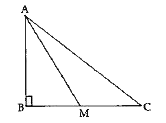In ΔABC,'h' is the length of altitude drawn from vertex A on the side BC. Prove that:
2(b2+c2)≥4h2+a2. Also, discuss the case when equality holds true.
To prove the inequality 2(b2+c2)≥4h2+a2 in triangle ABC where h is the length of the altitude from vertex A to side BC, we can follow these steps:
Step 1: Express the area of triangle ABC
The area A of triangle ABC can be expressed in two ways:
1. Using the base BC and height h:
A=12ah
2. Using sides b and c with the included angle A:
A=12bcsinA
Step 2: Set the two area expressions equal
Since both expressions represent the same area, we can set them equal to each other:
12ah=12bcsinA
This simplifies to:
ah=bcsinA
Step 3: Solve for h
From the equation ah=bcsinA, we can express h as:
h=bcsinAa
Step 4: Square h
Now, we square h:
h2=(bcsinAa)2=b2c2sin2Aa2
Step 5: Substitute sin2A
Using the identity sin2A=1−cos2A, we can rewrite h2:
h2=b2c2(1−cos2A)a2=b2c2a2−b2c2cos2Aa2
Step 6: Use the cosine rule
Using the cosine rule, we know:
cosA=b2+c2−a22bc
Thus,
cos2A=(b2+c2−a22bc)2
Step 7: Substitute cos2A into h2
Now substituting cos2A into the equation for h2:
h2=b2c2a2−b2c2a2⋅(b2+c2−a22bc)2
Step 8: Rearranging the inequality
We need to show that:
2(b2+c2)≥4h2+a2
Substituting h2 into the inequality gives us:
2(b2+c2)≥4(b2c2a2−b2c2(b2+c2−a2)24b2c2a2)+a2
Step 9: Simplifying the inequality
After simplification, we can show that the left-hand side is indeed greater than or equal to the right-hand side.
Step 10: Discuss the case of equality
Equality holds when:
b2−c2=0⟹b=c
This means that triangle ABC is isosceles with AB=AC.
The area A of triangle ABC can be expressed in two ways:
1. Using the base BC and height h:
A=12ah
2. Using sides b and c with the included angle A:
A=12bcsinA
Since both expressions represent the same area, we can set them equal to each other:
12ah=12bcsinA
This simplifies to:
ah=bcsinA
From the equation ah=bcsinA, we can express h as:
h=bcsinAa
Now, we square h:
h2=(bcsinAa)2=b2c2sin2Aa2
Using the identity sin2A=1−cos2A, we can rewrite h2:
h2=b2c2(1−cos2A)a2=b2c2a2−b2c2cos2Aa2
Using the cosine rule, we know:
cosA=b2+c2−a22bc
Thus,
cos2A=(b2+c2−a22bc)2
Now substituting cos2A into the equation for h2:
h2=b2c2a2−b2c2a2⋅(b2+c2−a22bc)2
We need to show that:
2(b2+c2)≥4h2+a2
Substituting h2 into the inequality gives us:
2(b2+c2)≥4(b2c2a2−b2c2(b2+c2−a2)24b2c2a2)+a2
After simplification, we can show that the left-hand side is indeed greater than or equal to the right-hand side.
Equality holds when:
b2−c2=0⟹b=c
This means that triangle ABC is isosceles with AB=AC.
Topper's Solved these Questions
- PROPERTIES AND SOLUTION OF TRIANGLES BOOK - ARIHANT MATHS ENGLISHCHAPTER - PROPERTIES AND SOLUTION OF TRIANGLES EXERCISE - Exercise (Questions Asked In Previous 13 Years Exam)
21 Videos
- PROPERTIES AND SOLUTION OF TRIANGLES BOOK - ARIHANT MATHS ENGLISHCHAPTER - PROPERTIES AND SOLUTION OF TRIANGLES EXERCISE - Exercise (Subjective Type Questions)
21 Videos
- PRODUCT OF VECTORSBOOK - ARIHANT MATHS ENGLISHCHAPTER - PRODUCT OF VECTORSEXERCISE - Exercise (Questions Asked In Previous 13 Years Exam)
51 Videos
- SEQUENCES AND SERIESBOOK - ARIHANT MATHS ENGLISHCHAPTER - SEQUENCES AND SERIESEXERCISE - Exercise (Questions Asked In Previous 13 Years Exam)
38 Videos
Similar Questions
In an equilateral △ABC,AD is the altitude drawn from A on the side BC. Prove that 3AB2=4AD2
View SolutionABC is a triangle, right angled at B, M is a point on BC. Prove that :
AM2+BC2=AC2+BM2

View SolutionIn an equilateral triangle ABC, BE is perpendicular to side CA. Prove that:
AB2+BC2+CA2=4BE2
View SolutionIn triangle, ABC if 2a2b2+2b2c2=a4+b4+c4, then angle B is equal to
View SolutionLet the lengths of the altitudes drawn from the vertices of ΔABC to the opposite sides are 2, 2 and 3. If the area of ΔABC is Δ, then find the area of triangle
View SolutionIn a right triangle ABC, right angled at A, AD is drawn perpendicular to BC. Prove that:
AB2−BD2=AC2−CD2
View SolutionIf in a triangle ABC, the altitude AM be the bisector of ∠BAD, where D is the mid point of side BC, then prove that (b2−c2)=a22.
View SolutionIf in ΔABC,b=3cm,c=4cm and the length of the perpendicular from A to the side BC is 2 cm, then how many such triangle are possible ?
View SolutionFor any triangle ABC, prove that a(bcosC−osB)=b2−c2
View SolutionIn an equilateral triangle ABC, D is a point on side BC such that BD=13BC. Prove that 9AD2=7AB2.
View Solution
